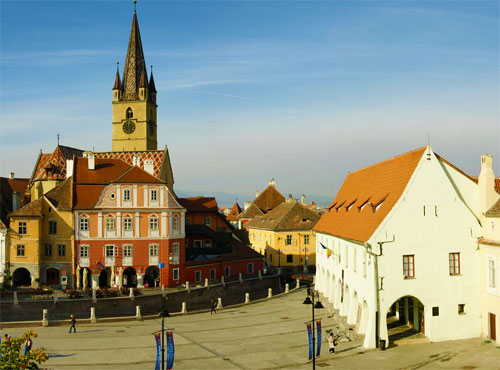The City of Sibiu
Known in German as Hermannstadt, Sibiu has always been the centre of Romania's German minority since medieval times. Even today, it contains Romania's largest German community, and, due to initiatives by the local government, the Germanic feel of the area has been maintained. Sibiu also has a significant Hungarian minority, remnants of Transylvania's past as part of the Hungarian Empire and, later, Austria-Hungary. Despite this, Sibiu is also distinctly Romanian (95% of the population are ethnic Romanians) and manages to fuse these three cultures, as well as smaller minorities of Roma, Slovaks and Ukrainians into a city that is as wonderful as it is vibrant.
Booking.com According to legend the lost children of Hamelin emerged from the ‘Almasch’ (Varghis) cave into Transylvania – somewhere close to Sibiu. This is the 'romantic' explanation for what was for many centuries a strange phenomenon: the presence of blond-haired, blue-eyed, German-speakers following ancient customs, yet isolated by hundreds of miles from Germany. The reality is that the fortified towns and villages of Transylvania were established in the 12th Century by settlers from the Moselle region, referred to locally as 'Saxons'.
According to legend the lost children of Hamelin emerged from the ‘Almasch’ (Varghis) cave into Transylvania – somewhere close to Sibiu. This is the 'romantic' explanation for what was for many centuries a strange phenomenon: the presence of blond-haired, blue-eyed, German-speakers following ancient customs, yet isolated by hundreds of miles from Germany. The reality is that the fortified towns and villages of Transylvania were established in the 12th Century by settlers from the Moselle region, referred to locally as 'Saxons'.
They were tempted to Transylvania by favourable market rights by the Hungarian rulers who wanted them there to guard the mountain passes against Tatar and Ottoman raiders. They created the 'Siebenbürgen', the seven fortified cities, while in villages they constructed fortified churches in which they could shelter during times of siege. Some of these churches are massive structures. The villages are often remote and although vestiges of the original populations may remain, clinging on to age-old traditions, many of them are in serious danger of losing their character as churches crumble. Various restoration projects have been initiated to rebuild the communities and to attract back some of the original inhabitants.
